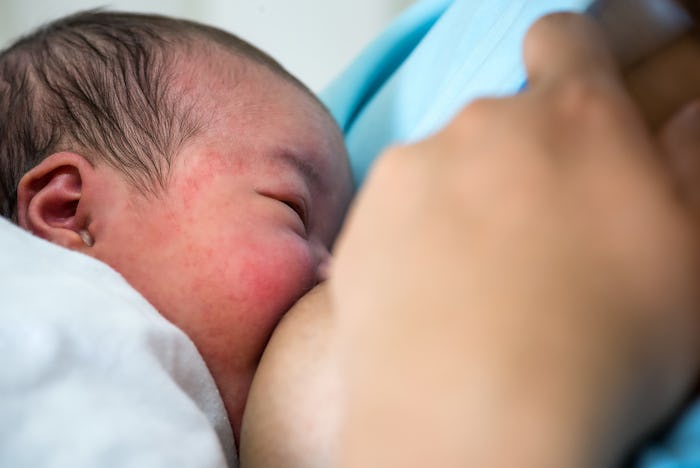When you're breastfeeding, it's hard not to use the phrase "liquid gold" to describe your breastmilk. You work so hard to produce it and pump it, that it feels like a crushing blow if even a drop goes to waste. But colostrum — the first breastmilk you produce after giving birth — is really the liquid gold. It provides so many incredible benefits for your newborn, you have to wonder just how much colostrum do you produce?
Before we get into the quantity, let's first just breakdown what exactly colostrum is, because you really couldn't dream up a more perfect food for your baby. Colostrum, aka newborn superfood, provides all the nutrients your baby needs in the first days of life. It is high in carbohydrates, high in proteins, and low in fats (which can be hard for a newborn to digest), according to Science Daily. Colostrum is also loaded with substances to protect against infections, according to HealthyChildren.org, the official site of the American Academy of Pediatrics. When you first see colostrum (and you might even get a glimpse of it before giving birth), it looks super rich and creamy yellowish. "Its color and thickness are due to the fact that it is higher in these protective factors," explained HealthyChildren.org.
Holding a tiny newborn for the first-time makes it clear just how fragile they are, and how susceptible they are to germs, but with colostrum, they get a little extra boost. "Colostrum contains large numbers of antibodies called "secretory immunoglobulin" (IgA) that help protect the mucous membranes in the throat, lungs, and intestines of the infant. Leukocytes are also present in large numbers; these begin protecting the infant from harmful viruses and bacteria," explained Science Daily.
You can see why you'd want to produce a lot of this liquid gold. However, your body only produces a very small amount of it because your baby's stomach is so small. "Most mothers will have teaspoons rather than ounces. During the first 24 hours after birth, an average of 37 ml of colostrum is produced (an ounce contains 30 ml). Babies take in an average of 7-14 ml at each feeding," advised Breastfeeding Basics.
In addition to the small quantity, colostrum is only around for a limited amount of time — about two to five days, according to MamaNatural. Yet, after about Day 5, it's not game-over entirely for the liquid gold. Your body will start producing what is called 'transitional milk', which contains a mixture of both colostrum and regular breastmilk, for about about 10 to 14 days, according to the same MamaNatural article.
It's during this phase that you may start feeling like your breasts are enormous and that your baby just can't get full. There's a reason for this too. Your body will start producing more milk to keep up with your growing baby's increased demand, according HealthyChildren.org. "Daytime feedings may be anywhere from one and a half to three hours apart and may range in length from ten minutes to close to an hour each," explained the HealthyChildren article..
After about two weeks, your body will start producing mature milk, according to VeryWell Family, and that milk is thinner and can appear almost bluish in color. Mature milk is the third and final stage of breastmilk, but that's not the end of your breastmilk fluctuations. Your breastmilk will change with each feeding, from morning to night, and as your baby grows, to meet the particular needs of your baby, according to the same VeryWell Family article.
From colostrum to mature milk, it's pretty amazing what the female body can do.
